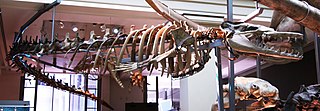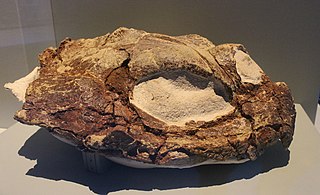
Basilosaurus is a genus of large, predatory, prehistoric archaeocete whale from the late Eocene, approximately 41.3 to 33.9 million years ago (mya). First described in 1834, it was the first archaeocete and prehistoric whale known to science. Fossils attributed to the type species B. cetoides were discovered in the United States. They were originally thought to be of a giant reptile, hence the suffix "-saurus", Ancient Greek for "lizard". The animal was later found to be an early marine mammal, prompting attempts at renaming the creature, which failed as the rules of zoological nomenclature dictate using the original name given. Fossils were later found of the second species, B. isis, in 1904 in Egypt, Western Sahara, Morocco, Jordan, Tunisia, and Pakistan. Fossils have also been unearthed in the southeastern United States and Peru.
Yurlunggur is a genus of fossil snake in the extinct family Madtsoiidae containing the species Yurlunggur camfieldensis known from the Oligocene and Miocene of Australia.
Potamotherium an extinct genus of caniform carnivoran from the Miocene epoch of France and Germany. It has historically been assigned to the family Mustelidae, but more recent studies suggest that it represents a primitive relative of pinnipeds
Anatibetites is an extinct genus of cephalopods belonging to the Ammonite subclass.
Anisarcestes is an extinct genus of cephalopod belonging to the Ammonite subclass.
Argosirenites is an extinct genus of cephalopods belonging to the Ammonite subclass.

Epihippus is an extinct genus of the modern horse family Equidae that lived in the Eocene, from 46 to 38 million years ago.

Lunaspis is an extinct genus of armor-plated petalichthyid placoderm fish that lived in shallow marine environments of the Early Devonian period, from approximately 409.1 to 402.5 million year ago. Fossils have been found in Germany, China and Australia. There are three different identified species of within the genus Lunaspis: L. broilii, L. heroldi, and L. prumiensis.

Psephophorus is an extinct genus of sea turtle that lived from the Oligocene to the Pliocene. Its remains have been found in Europe, Africa, North America, and New Zealand. It was first named by Hermann von Meyer in 1847, and contains seven species, P. polygonus, P. calvertensis, P. eocaenus, P. oregonesis, P. californiensis, P. rupeliensis, P. scaldii, and a species discovered in 1995, P. terrypratchetti.

Megalictis is an extinct genus of large predatory mustelids that existed in North America during the "cat gap" from the Late Arikareean (Ar4) in the Miocene epoch. It is thought to have resembled a huge, jaguar-sized ferret, weighing up to 60–100 kilograms (130–220 lb).
Brachypsalis is an extinct genus of mustelids, which existed during the Miocene period.

Oligobuninae is an extinct subfamily of the family Mustelidae known from Miocene deposits in North America.
Oligobunis is an extinct genus of mustelids, which existed during the Miocene epoch.
Zodiolestes is a genus of mustelids, now extinct, which existed during the Miocene period.
Litoceras is a trocholitid (Tarphycerida) genus that has been found in the Lower and Middle Ordovician of Newfoundland. Whorls in Litoceras have a broadly rounded cross section with its width greater than its height. Litoceras somewhat resembles the tarphyceratid Pionoceras from the same time, except for the siphuncle being dorsal and in the center.
Procerosuchus is an extinct genus of loricatan archosaur. Fossils have been collected from the Late Triassic Santa Maria Formation in Geopark of Paleorrota, Rio Grande do Sul, Brazil, which is Carnian in age. The genus was first described by the German paleontologist Friedrich von Huene in 1942.

Deltavjatia was a pareiasauromorph procolophonoid from the Tatarian stage of the Permian time period. It had a large body of about 1.5 m (4.9 ft) in length. Deltavjatia was an herbivore and lived in what is now Russia. The first specimen of Deltavjatia was a specimen of a skull and lower mandible, found in the Urpalov Formation in Kotelnich, Vyatka River. Since then, numerous mostly complete skeletons have been found, many of them being so well preserved due to the silty, anaerobic environment of the Kotelnich deposits that fossilised white blood cells are able to be distinguished in them. Analyses of the bone histology of Deltavjatia show that they grew very rapidly during the early stages of their ontogeny but that their growth rate drastically slowed down once they reached approximately half of their full body size.
Aaglacrinus is an extinct genus of crinoidea in the Cladia order. It has been proposed that it was a stationary (attached) suspension feeder the hard parts of which were composed of magnesium calcite.
Foozia was a genus of vascular Emsian land plant with a main axis and a number of branches that sub-divide at most once. Some of these bear oval to semicircular sporangia containing Dibolisporites echinaceus, whereas the sterile branches may represent an early foray into leaf-formation. The only known fossils herald from Belgium. It is currently unclassified.
Gangshanoceras is a fossil nautiloid cephalopod genus included in the orthocerid family Proteoceratidae. It has been found in Ordovician rocks dated from about 478.5 to 468 Ma in China, and from rocks dated slightly younger, about 468 to 461 Ma in Argentina. It has five described species. The type is Gangshanoceras jurongense.













